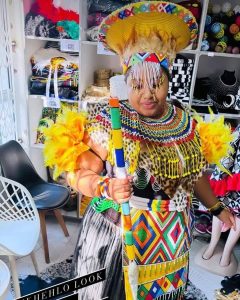Zulu Bridal Outfit: Beauty And Elegance Displayed
Elegance and glamour are the chief characteristics of any gathering, and this is reflected in music, dance, art, and fashion. A popular hub for art, music, dance and culture at large is Zulu in South Africa. The Zulu people are the single largest ethnic group in the province of South Africa and its language the most spoken. They are known and vast in weaving, craft-making, beading, poetry, music, dance, and hunting. Their bead work, dance, art, and music serve as a communication tool and a great source of unity and relationship.
Clothing characterizes each stage or phase of the life of an average Zulu native, from infant to the umemulo period (a period for celebrating a lady who has turned 21 years), there is equally a special dress for pregnant women called isibamba and a hairnet for engaged women.
Some scholars or writers have this to say about the Zulu people in terms of their clothing obsession ‘‘The females wear a black hide skirt called the isidwaba. Unmarried girls would leave their upper bodies open, while the married and engaged would cover them with a piece of animal skin (isicwaya) or cloth. These young maidens adorn themselves with izincu (beads), worn as anklets, bracelets, knee bands, etc. The married women also wear a cone-shaped hat with a wide end called an isicholo. Although this has been adapted in the modern world as a cap, the shape of this headwear used to be achieved by weaving the woman’s hair with fibre and grass to show her marital status.’’


A Typical Zulu Bride Traditional Outfit:
One of the most inspiring and beautiful moment to behold in a typical Zulu bride is her marriage period and dressing. Because the Zulu people are fierce warriors and brave hunters, animal skin is a major instrument of their fashions including wedding attires or outfit. A classic Zulu wedding dress will include an isidwaba, a leather skirt and a skin to cover the breast called isicwaya. This is followed with a hart traditionally worn by married women of Zulu, this hart is called inkehi or isicholo which is a sign that the young woman is no longer available for courting.


In addition to animal skins, the bride is most times expected to wear beads across their chests, as well as a beaded veil, they also wear imvakazi (this includes twisted fig leaves for most cases), bags of pebbles are tied around her ankles which makes sharp noise as she danced.
There is also a twisted calfskin strung in a coil over the bride’s shoulders and under her arms, and bangles made from white cow-tail fringes are traditionally worn around both arms and knees. In addition to all of these, the new bride carries a small assagai (it will be pointed up) which signifies her strength and equally symbolizes her virginity which is pointed down after the marriage is consummated.
HERE for you: You can contact us for your Zulu bride outfit and equally feel free to check out this stunning Zulu outfit and tell us what you think.
https://macklemorefashions.com/product/zulu-bridal-outfit/
or check other marriage outfits here:
https://macklemorefashions.com/product-category/couple-marriage-outfit/
